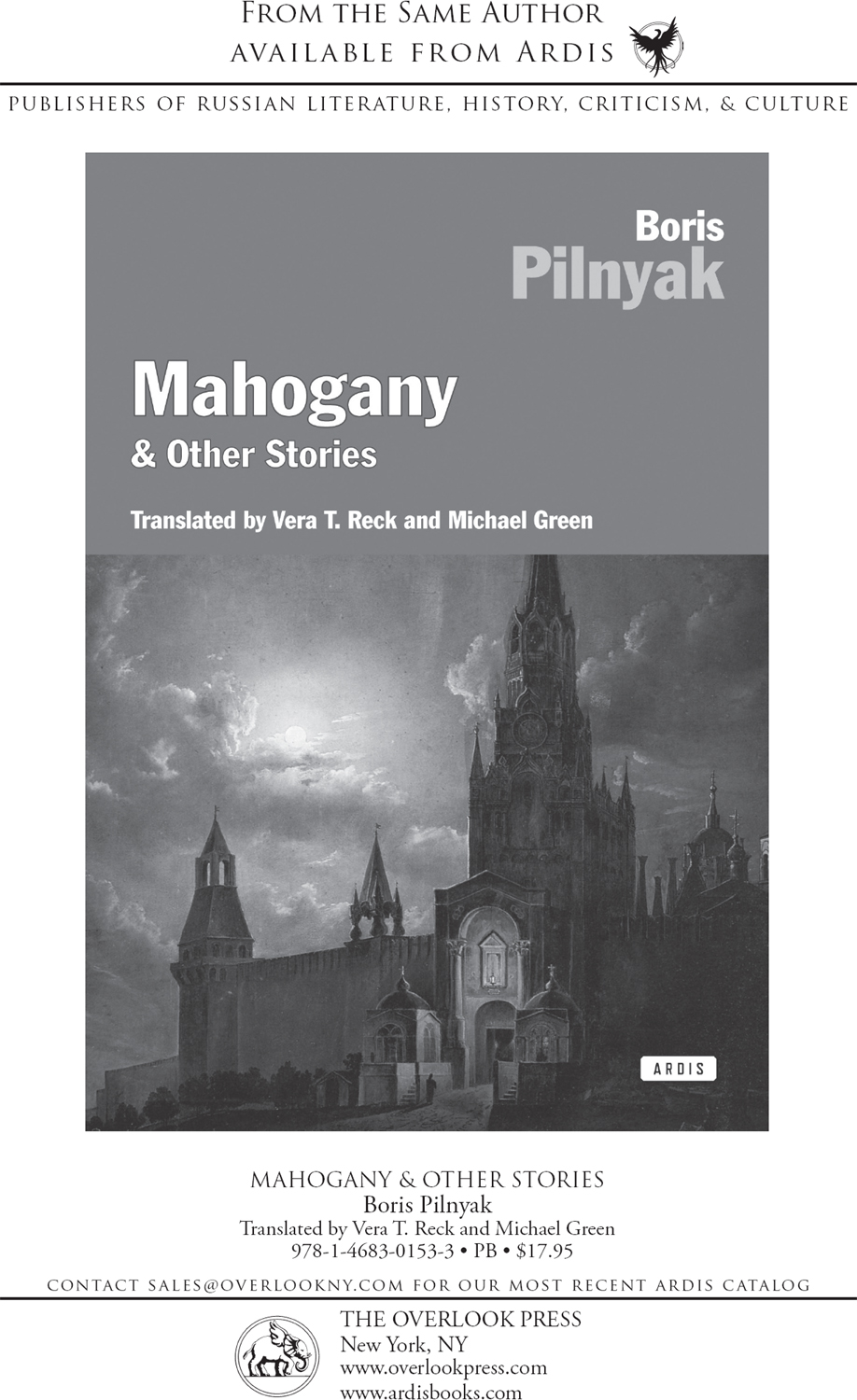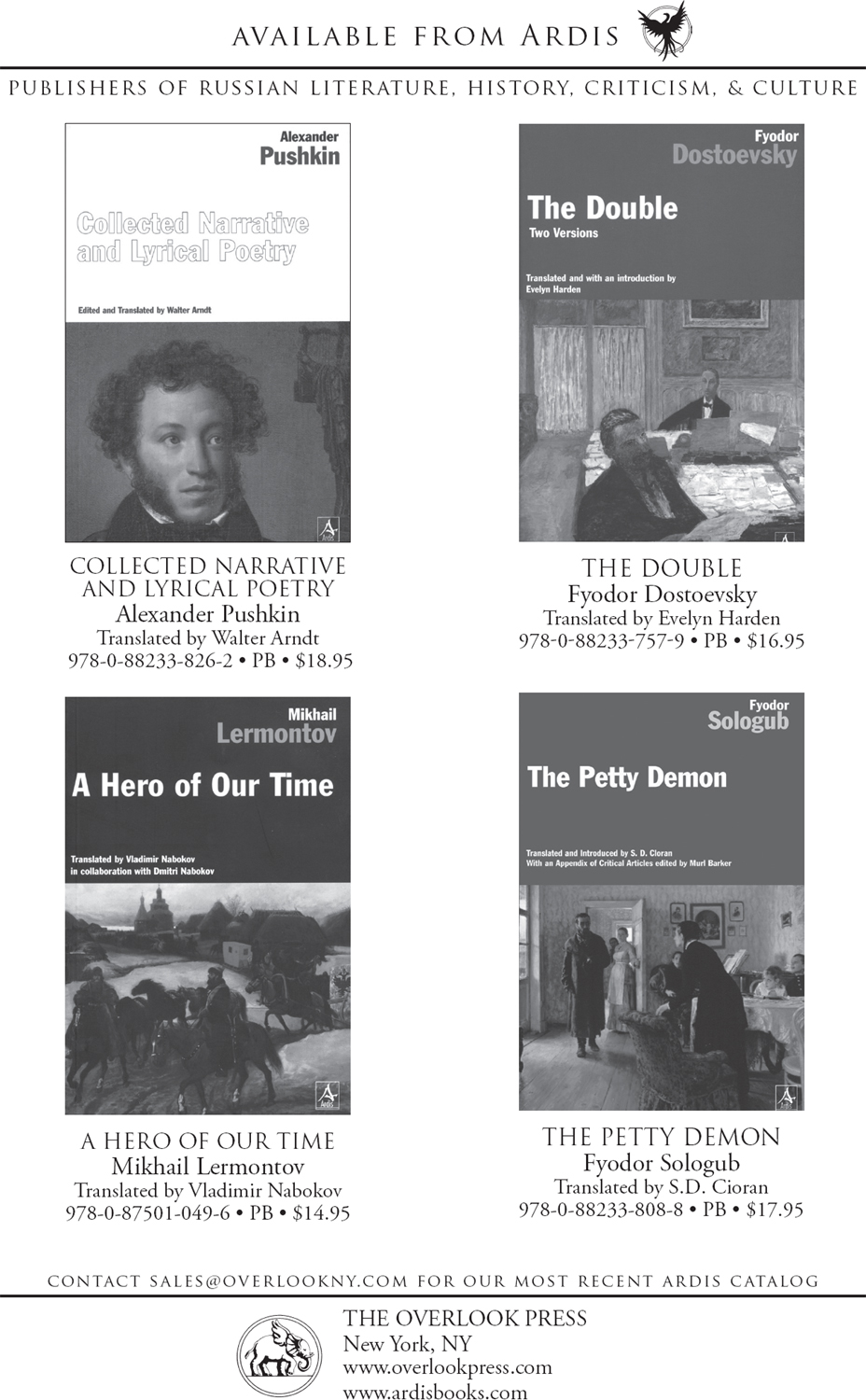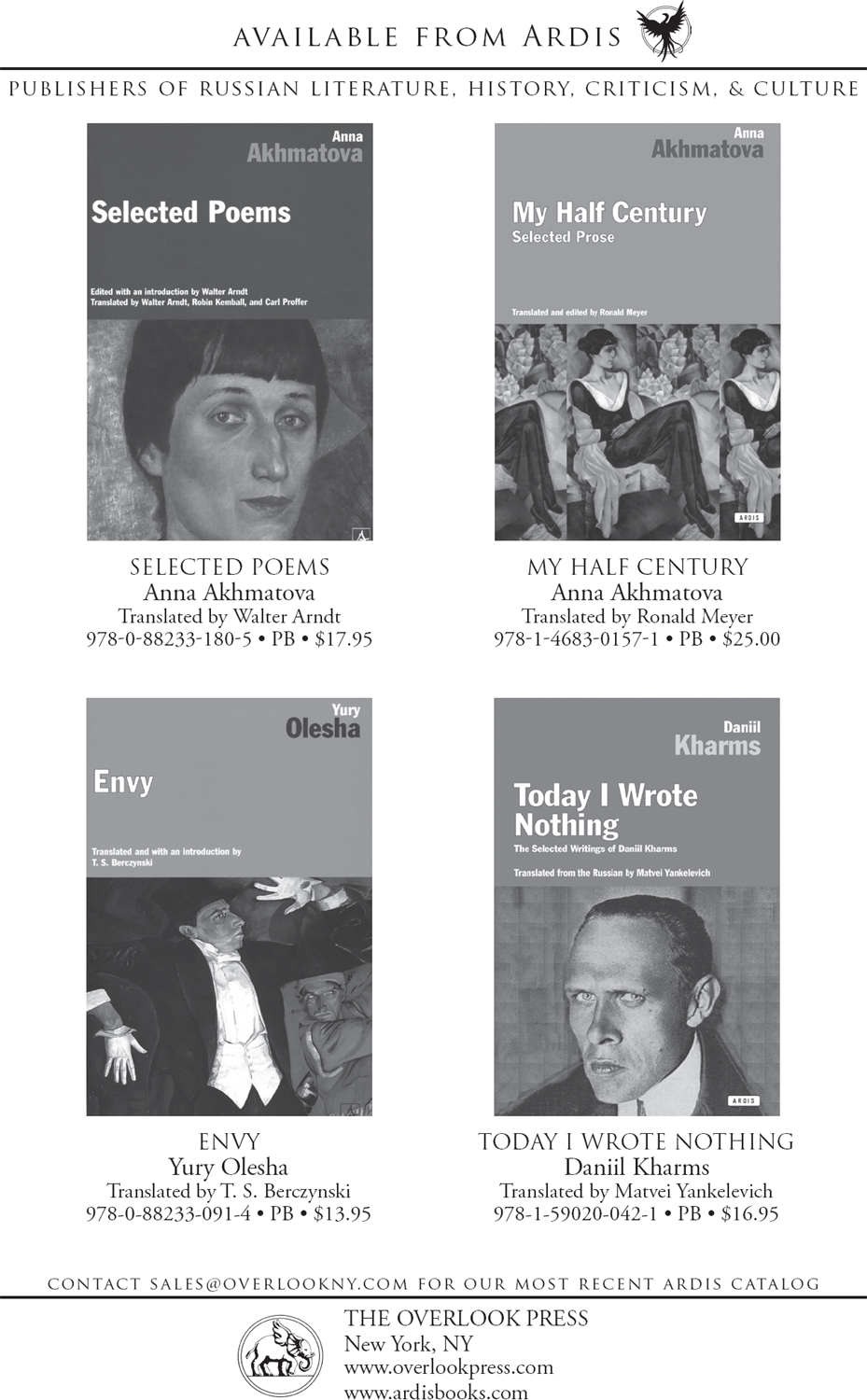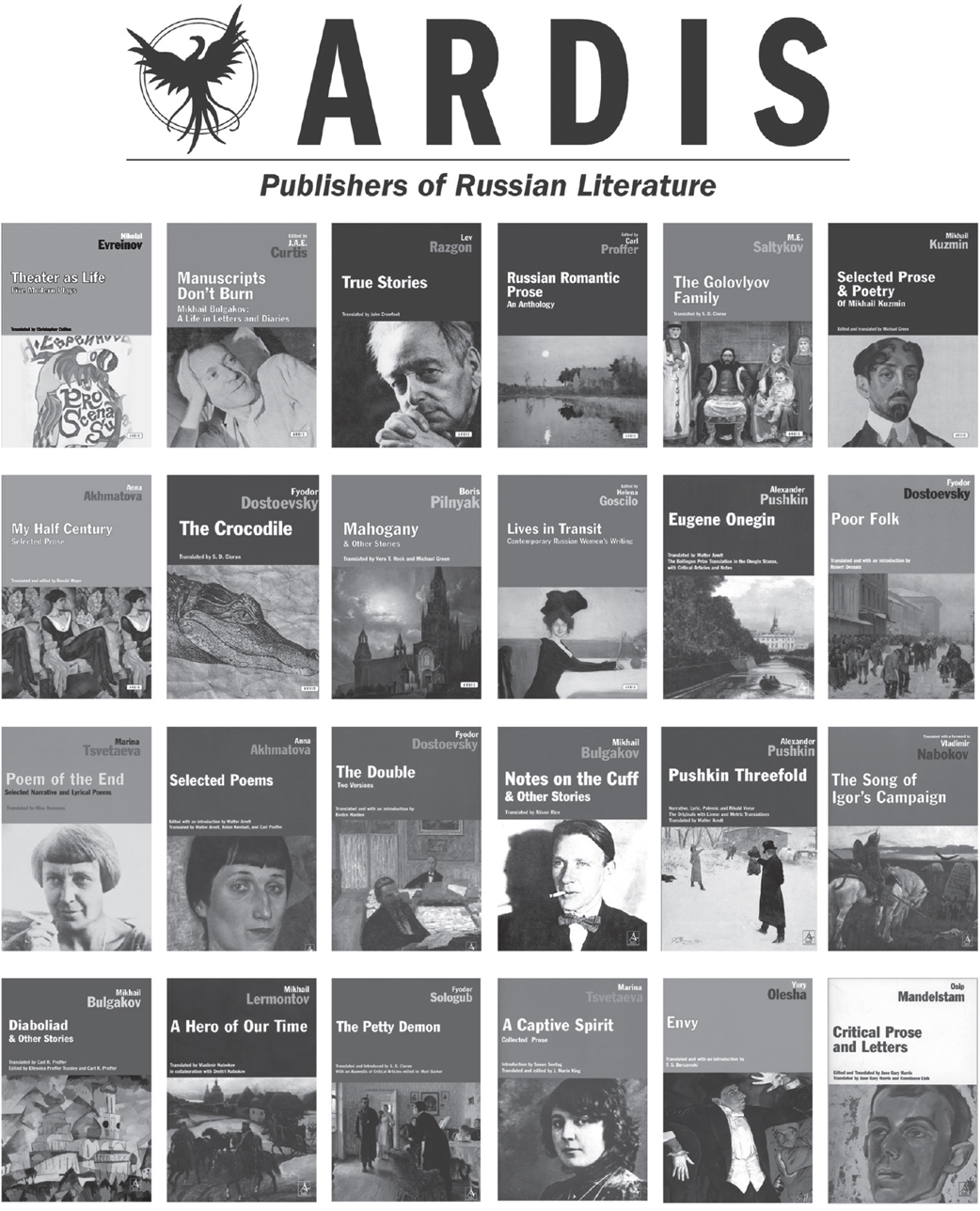The Naked Year (22 page)
Authors: Boris Pilnyak
Tags: #Fiction, #General, #Bisac Code 1: FIC000000; FIC019000

Pilnyak's Bolsheviks contrast sharply to the prototype of the “Soviet New Man” whom writers in the Soviet Union have been required to depict in literature since the inception of Socialist Realism in 1932. Taking as their model Pavel Vlasov, the hero of Gorky's
Mother
(1907), writers were required to portray heroes as paragons of all the Socialist virtues such as compassion, dynamism and dedication to the cause. Although Pilnyak's novel predates Socialist Realism, the retrospective nature of the doctrine made him, along with writers such as Babel and Zamyatin, persecution fodder when Stalin purged the intellectuals of dissident influences. Almost without exception Pilnyak dwells on the negative qualities of the Bolsheviks' mentality; and descriptions such as those already mentioned, combined with the behavioral implications of such attitudes of mind, served only to add fuel to the fire. The insensitivity implicit in Laitis's “bourgeois” activities is made explicit when Pilnyak starkly portrays the institutional disregard for human life in passages such as this:
On that day, at that hour intrepid was the word written in the Executive Committee roomâby the son Arkhip Arkhipov:â
TO BE SHOT.
The arbitrary powers of arrest implied by Olga Kuntz's churning out of arrest warrants on the duplicating machine indicates a lack of freedom for individuals which equalled, if not surpassed, the restrictions placed on society by the Tsarist regimes. It is not that the Bolsheviks were necessarily more efficient, but the arbitrariness of such widespread arrests produced a social system in which no one was immune from the possibility of undeserved incarceration. And as we see when Laitis himself is arrested, the wrath of the Party was just as likely to descend on the faithful as on the miscreants.
Western readers know writers in the Soviet Union are made to toe the Party line by rigorous censorship measures and other bureaucratic controls (witness the notoriety surrounding the literary and legal hounding of Pasternak, Sinyaysky, Daniel, and Solzhenitsyn), While this is undoubtedly true, it should be remembered that immediately following the Revolution, and during the New Economic Policy (1922-28), writers were afforded some degree of freedom; and a number of them elected either to deal with the Revolution in terms which were not entirely laudatory, or to ignore it entirely.
The Twenties were charged with experimental ardor. The works of the Serapion Brothers, the Futurists, and Constructivists are obvious examples. It was also the era of attempts to create a literature with roots firmly embedded in the proletariat, written by artisans and engineers for artisans and engineers. Many writers' schools came into being at this time, all of them concerned with adapting the literary heritage of Russia to the needs and hopes of the new society. They wanted to break down the class distinctions associated with a literature deriving from and intended for an educated minority. However, few of these groups survived more than a few years, and those which went by such un-inspiring names as “Smithy,” “On-guardists,” and “Proletcult” are now of interest only to literary historians.
But Pilnyak was never one of those writers who were concerned about the creation of a literature of the masses; and he took advantage of the relative artistic freedom to continue (after
The Naked Year
) to write on themes which interested him, and in the style which he found most natural and suitable to those themes. In these works the Revolution is somewhat underplayed, or it is dealt with as a source of demonstrable proofs for his own theories. In “Ivan and Maria” (1922) Pilnyak continued to describe the Revolution in the experimental prose of
The Naked Year
, showing its sociological shortcomings and failure to create a society based on universal equality. In 1924 his novel
The Third Capital
(also called
Mother-Stepmother
) was published in Berlin. This novel used the theories of Spengler, including the idea that civilization, which had originated in the East, was now moving through Europe and would then continue through America and emerge again in Russia. In 1924, in his novel
Machines and Wolves
(published 1925) Pilnyak depicted the Revolution as a technological rather than sociological one, with the main conflict between the individual and the machine. Pilnyak saw the machine as a potentially greater (and more anonymous) tyrant than even the Bolsheviks.
In 1926 a watershed was reached in Pilnyak's career. This was the year in which “The Tale of the Unextinguished Moon” was published, and its publication placed the author under permanent suspicion. The story appears to deal with the mystery surrounding Stalin and his involvement in what has since come to be known as the “Frunze Affair.” Red Army Commander Mikhail Frunze was virtually forced by Stalin to undergo an operation which he did not need; and he died (or was murdered) on the operating table. Pilnyak protested that there was no real connection between the story and Frunze's death, but the similarity between the story and the rumors is much too pronounced for one to believe his recantations.
The last of Pilnyak's experimental works was
Ivan Moscow
of 1927. It is perhaps the most cryptic of all his works, blending as it does the stylistic chaos and surrealist imagery of his earlier works with a hallucinatory confusion of time, symbolic references to Egyptian mummies, life-like puppets, and a syphilitic central character. The basic theme of this story, as in
Machines and Wolves
, is the role which the machine is to play in the new, industrialized Soviet Union; but here Pilnyak emphasizes the destructive effect the machine can have on man's intellect.
A year after the publication of
Ivan Moscow
, 1928, the Russian Association of Proletarian Writers was set up as a sort of watchdog committee whose function it became to “protect” Soviet literature against non-conformist elements; and as such it paved the way for the single Union of Soviet Writers (1932), and introduction of Socialist Realism and its concomitant Social Command as the iron rule for all Soviet writers. The adoption of and propaganda for the First Five-Year Plan in 1928 also helped erode the relative freedom writers had enjoyed. Pilnyak was head of the Moscow section of the liberal All-Russian Writers' Union in 1929 when his short novel
Mahogany
was published abroad (for copyright purposes). This gave RAPP an excuse to attack him with special fervor, calling him a criminal and conspirator, linking him to Evgeny Zamyatin (head of the Leningrad section of the Writers' Union) as men opposed to the new ideology. Pilnyak recanted publicly. But his new works were not very exciting.
The Volga Flows into the Caspian Sea
(1930) was intended as rejection for his former “errors”; but its central theme, the construction of a Soviet hydroelectric dam, was of palpably little interest to him, and partly because a revised
Mahogany
was included in it as an integral part, not only did it fail as a work of art, it also failed to convince the Party hierarchy that its author's conversion was genuine. His
O'Kay
(1933) was another attempt to curry favor with the mandarins of Soviet literature. This was not a novel but a collection of impressions recorded during a brief visit to America in 1933. A politically biased piece of anti-American propaganda, this work also has little to recommend it as a work of literature; its chief value lies in its demonstration of how the Soviet bureaucratic mania for conformity was able to destroy a writer who could have been one of the most interesting to emerge from post-Revolutionary Russia. In his book about Japan,
Stones and Roots
(1934), Pilnyak advocates such strict control of writers that one almost thinks he is being ironical. But he had little time left to practice his craft; his last book,
The Ripening of the Fruit
, was published in 1936, and he was arrested in 1937. According to one story he was shot as a Japanese spy. His exact fate has still not been revealed, but the Soviet
Shorter Literary Encyclopedia
gives 1937 as the year of his death.
Alexander R.
Tulloch
Northern Ireland,
August, 1974
Selected Bibliography of
Works about Pilnyak
Aikhenval'd, B. “O romane Pil'niaka,
Volga vpadaet v Kaspiiskoe more,” Krasnaia nov',
No. 4 (1931), 178-86.
Alexandrova, Vera.
A History of Soviet Literature, 1917-64
. New York: Doubleday, 1964.
Annenkov, Iurii. “Boris Pil'niak,”
Dnevnik moikh vstrech
. Inter-Language Literary Associates, 1966. Volume I, 288-99.
Blake, Patricia & Max Hayward, eds.,
Dissonant Voices in Soviet Literature
. New York: Pantheon, 1962.
Borland, Harriet.
Soviet Literary Theory and Practice during the First Five-Year Plan, 1928-32
. New York: King's Crown Press, 1950.
Bristol, Evelyn. “Boris Pil'njak.”
Slavonic and East European Review
, XLI (June 1963), 494-512.
Brostrom, Kenneth. “The Novels of Boris Pilnyak as Allegory,” Ph.D. Diss. University of Michigan, 1973.
Brown, Edward J.
Russian Literature Since the Revolution
. 2nd rev. ed. New York: Collier Books, 1969.
Browning, Gary L. “Boris Pilnyak as Phenomenon and Artist,” Ph.D. Diss. Harvard, 1974.
Eastman, Max.
Artists in Uniform: a Study of Literature and Bureaucratization
. New York: Knopf, 1934. pp. 104-25.
Hayward, Max. “Pilnyak and Zamyatin: Two Tragedies of the Twenties,”
Survey
, 36 (April-June, 1961), 85-91.
Holthusen, J.
Twentieth Century Russian Literature
. New York: Ungar, 1972. pp. 125-31.
Jackson, Robert L.
Dostoevskij's Underground Man in Russian Literature
. The Hague: Mouton, 1958.
Kazanskii, B. V. and Iu. N. Tynianov, eds.,
Boris Pil'niak: stat'i i materialy
. Leningrad: Academia, 1928. Reprint, Ardis: Ann Arbor, 1971.
Lidin, V. “Pil'niak-avtobiografiia,”
Pisateli
. Moscow, 1928. pp. 267-29.
Luke, Louise E. “Marxian Women: Soviet Variants,”
Through the Glass of Soviet Literature: Views of Russian Society
. Ed. Ernest J. Simmons. New York: Columbia University Press, 1953.
L'vov-Rogachevskii, V.
Noveishaia russkaia literatura
. M. 1927.
Maguire, Robert. “Pilnyak,”
Red Virgin Soil: Soviet Literature in the 1920's
. Princeton, 1968. pp. 101-28. Reprinted in E. J. Brown, ed.,
Major Soviet Writers
. Oxford University Press, 1973. pp. 221-41.
Muchnic, Helen. “Literature in the NEP Period,”
Literature and Revolution in Soviet Russia, 1917-62, a Symposium
. Ed. Max Hayward and Leopold Labedz. London: Oxford University Press, 1963.
Oulanoff, Hongor.
The Serapion Brothers: Theory and Practice
. The Hague: Mouton, 1966.
Palievskii, P. “Eksperimental'naia literatura,”
Voprosy literatury
, No. 8 (1966).
Pilnyak, Boris.
Mother Earth and Other Stories
. Introduction by V. T. Reck and Michael Green. Garden City: Doubleday, 1968. pp. xi-xviii.
Polianov, P. “Boris Pil'niak:
Mashiny i volki.” Molodaia gvardiia
(1926), pp. 204-206.
Polonskii, Viacheslav. “Kriticheskie zametki: shakhmaty bez korolia,”
Novyi Mir
, No. 10 (1927), 170-93.
Reilly, A. P. “Boris Pilnyak:
Okay, An American Novel,” America in Contemporary Soviet Literature
. New York University Press, 1971. pp. 23-30.
Shklovskii, Viktor. “O Pil'niake,”
Piat' chelovek znakomykh
. Tiflis, 1927.
Slonim, Marc.
Soviet Russian Literature
. New York: Oxford University Press, 1967.
Struve, Gleb.
Russian Literature under Lenin and Stalin, 1917-53
. Norman: University of Oklahoma Press, 1971.
Trotsky, Leon.
Literature and Revolution
. Ann Arbor: University of Michigan Press, 1960.
Tulloch, A. R. “The âMan-vs. Machines' Theme in Pilnyak's
Machines and Wolves,” Russian Literature Triquarterly
, No. 8 (Winter 1974), 329-41.
Voronskii, A. K. “Literaturnye siluety: Boris Pil'niak,”
Krasnaia nov
', No. 4 (1922), 252-69. Reprinted in his
Literaturnye portrety
, Moscow, 1928. Volume I, 401-446.
Wilson, Peter. “Boris Pilnyak,”
Survey
, 46 (January 1963), 134-42. Zamyatin, Yevgeny.
A Soviet Heretic: Essays
. Ed. Mirra Ginsburg. Chicago: Chicago University Press, 1970.



